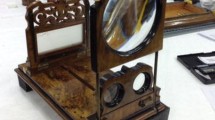Abstract
“3D display technologies are evolving very rapidly particularly in respect of autostereoscopic systems which are able to be used without viewing glasses, and which provide much greater freedom in vantage position. However, significant questions still remain in relation to the perceptual mechanisms that underpin the 3D experience. Here we provide general background discussion as a precursor to other entries which review approaches in more detail.”
Access this chapter
Tax calculation will be finalised at checkout
Purchases are for personal use only
Similar content being viewed by others
Further Reading
Blundell BG (2007) Enhanced visualization: making space for 3-D images. Wiley, Hoboken
Blundell BG (2011) 3D displays and spatial interaction. Exploring the science, art, evolution and use of 3D technologies. Walker & Wood Ltd. Also available for download https://www.dropbox.com/sh/r96nhin3od4z81t/hepxE7-ju1. Accessed Mar 2015
Blundell BG (2012) On exemplar 3D display techniques: summary discussion. www.barrygblundell.com. Accessed Mar 2015
Blundell BG (2014) On aspects of glasses-free 3D cinema ~70 years ago. https://www.dropbox.com/sh/uw3yjnwn3qo9z1e/SyPYAkHSqc. Accessed Mar 2015
Blundell BG (2015) On curious 3D perception phenomena: stereoscopy – by default, discussion document. www.barrygblundell.com. Accessed Mar 2015
Brewster SD (1883) Letters on natural magic. Chatto and Windus, London
Claparède E (1904) Steréréoscopie monoculaire paradoxale. Ann Ocul 132:465–466
Enright JT (1993) Paradoxical monocular stereopsis and perspective vergence. In: Ellis S (ed) Pictorial communication in virtual and real environments, 2nd edn. Taylor & Francis Inc, Bristol, pp 567–576
Gabor D (1960) Three-dimensional cinema. New Sci 8(191):141–145
Ivanov SP (1945) Rastrovaia Stereoskopiia v Kino. Goskinizdat, Moskva
Kemp M (1978) Science, non-science and nonsense: the interpretation of brunelleschi’s perspective. Art History 1(2):134–161
Koenderink JJ, van Doorn AJ, Kappers AML (1994) On so-called paradoxical monocular stereoscopy. Perception 23:583–594
Koenderink JJ, Wijntjes M, Van Doorn A (2013) Zograscopic viewing. i-Perception 4:192–206
Marion F (1890) L’Optique (4th ed). Librairie Hachette et Cie, Paris
Okoshi T (1976) Three-dimensional imaging techniques. Academic Press, New York
Pirenne MH (1970) Optics, painting and photography. Cambridge University Press, London
Pirenne MH (1975) Vision and art. In: Carterette EC, Friedman MP (eds) Handbook of perception, Vol 5, Seeing. Academic Press, New York, pp 433–490
Schlosberg H (1941) Stereoscopic depth from single pictures. Am J Psychol 54(4):601–605
Symanzik J (1993) Three-dimensional statistical graphics based on interactively animated anaglyphs. In: Proceedings of section on statistical graphics, American Statistical Association, Alexandria
Tidbury LP, Black RH, O’Connor AR (2014) Perceiving 3D in the absence of measurable stereo-acuity. Br Ir Orthopt J 11:34–38
Valyus NA (1966) Stereoscopy. The Focal Press, London
Vishwanath D (2011) Visual information in surface and depth perception: reconciling pictures and reality. In: Albertazzi L, van Tonder G, Vishwanath D (eds) Perception beyond inference: the information content of visual processes. MIT Press, Cambridge, MA, pp 201–240
Vishwanath D (2014) Towards a new theory of stereopsis. Psychol Rev 121(2):151–178
Vishwanath D, Hibbard PB (2013) Seeing in 3D with just one eye: stereopsis without binocular vision. Psychol Sci 24:1673–1685
Wade NJ (ed) (1983) Brewster and wheatstone on vision. Academic Press, London/New York
Wade NJ (1987) On the late invention of the stereoscope. Perception 16:785–818
Author information
Authors and Affiliations
Corresponding author
Editor information
Editors and Affiliations
Rights and permissions
Copyright information
© 2016 Springer International Publishing Switzerland
About this entry
Cite this entry
Blundell, B.G., Fihn, M. (2016). Introduction to 3D Displays. In: Chen, J., Cranton, W., Fihn, M. (eds) Handbook of Visual Display Technology. Springer, Cham. https://doi.org/10.1007/978-3-319-14346-0_108
Download citation
DOI: https://doi.org/10.1007/978-3-319-14346-0_108
Published:
Publisher Name: Springer, Cham
Print ISBN: 978-3-319-14345-3
Online ISBN: 978-3-319-14346-0
eBook Packages: EngineeringReference Module Computer Science and Engineering



